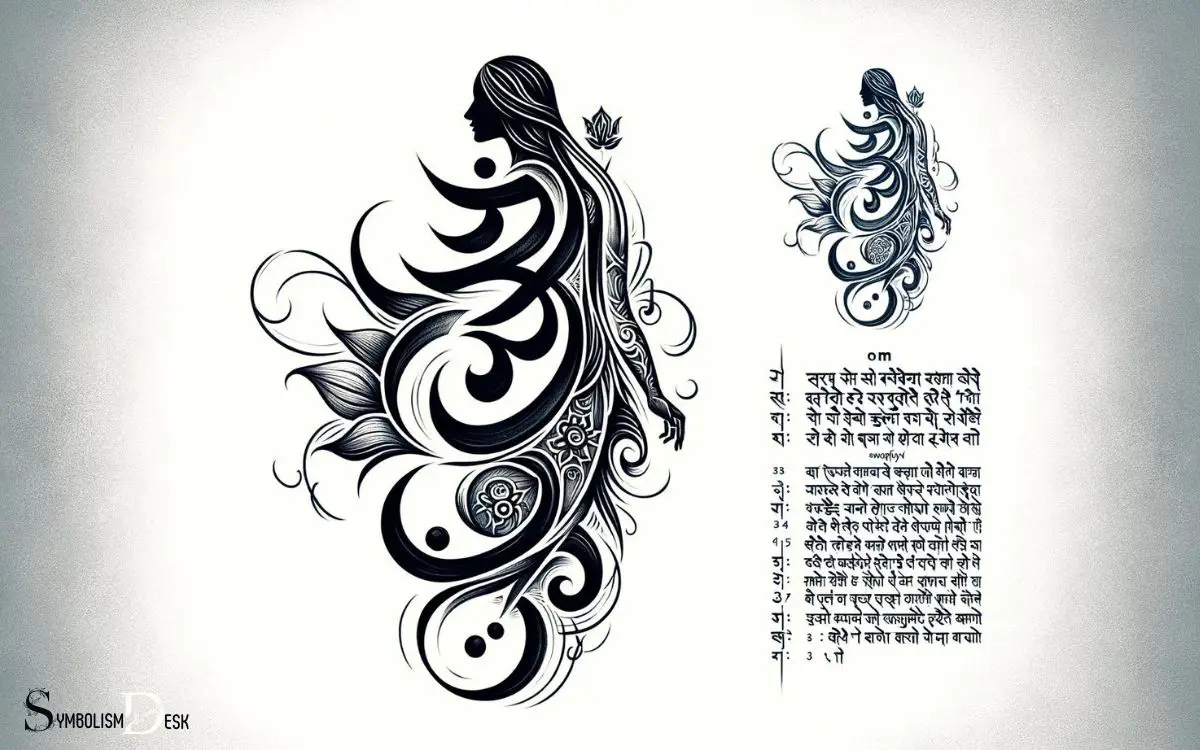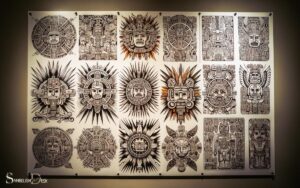Symbol Sanskrit Tattoo With Meaning: Explain!
Sanskrit symbols are increasingly popular for tattoos due to their intricate designs and profound meanings.
Derived from an ancient language, these symbols often embody spiritual concepts, philosophical ideas, or are mantras that hold significant cultural importance.
When considering a Sanskrit tattoo, it is essential to understand the meaning of the symbol, ensure accurate translation and script, and respect the cultural heritage it represents.
Sanskrit is an ancient Indo-European language of India, which is still used in liturgical and scholarly contexts.
Tattoos featuring Sanskrit symbols can include:
- Om (ॐ): A sacred sound and spiritual icon in Indian religions. It signifies the essence of the ultimate reality or consciousness.
- Lotus (पद्म): Represents purity, enlightenment, and rebirth.
- Trishula (त्रिशूल): Symbolizes various trinities, such as Creation, Maintenance, and Destruction or Past, Present, and Future.
It’s crucial to research the symbol’s background, consult with experts in the language and culture, and find a skilled tattoo artist familiar with Sanskrit script to ensure accuracy.
Embrace the profound essence of Sanskrit symbols with a tattoo that honors the ancient traditions and carries a personal spiritual journey.

Key Takeaway
Origins of Sanskrit Symbols
Originating from ancient Indian scriptures, Sanskrit symbols hold deep cultural and spiritual significance.
The origins of these symbols can be traced back to the Vedic period, around 1500 BCE. Sanskrit, the sacred language of Hinduism, is the source of these symbols, which have been used in various religious and cultural contexts.
The symbols are often associated with profound meanings, representing concepts such as enlightenment, unity, and spiritual growth. They’re believed to possess the power to protect and guide individuals on their spiritual journey.
Over time, Sanskrit symbols have transcended their original religious significance and are now appreciated for their aesthetic beauty and the sense of connection they provide to ancient traditions.
Today, these symbols continue to be popular choices for tattoos, serving as a reminder of the deep wisdom and spirituality they encapsulate.
Spiritual Significance of Sanskrit Tattoos
Sanskrit tattoos hold a deep spiritual significance for many individuals. The sacred nature of Sanskrit script is intertwined with the spiritual beliefs and practices of Hinduism, Buddhism, and Jainism.
Understanding the spiritual connection between Sanskrit symbols and enlightenment is essential for appreciating the profound meaning behind these tattoos. These symbols often serve as a visual representation of inner peace, mindfulness, and the journey toward higher consciousness. In many cases, Buddhist tattoo symbols explained through their intricate designs and sacred geometry reveal layers of spiritual teachings and philosophies. By delving into their origins and meanings, one can uncover a deeper appreciation for their significance in both personal growth and spiritual awakening.
Sanskrit as Sacred Script
Why do people choose to get Sanskrit tattoos, and what spiritual significance do these tattoos hold?
Sanskrit is considered a sacred script in Hinduism, Buddhism, and Jainism, making it a popular choice for tattoos with spiritual meaning.
The significance of Sanskrit tattoos lies in:
- Ancient Wisdom: Many people see Sanskrit as a language of ancient wisdom and spirituality, making it a way to connect with profound teachings and philosophies.
- Divine Connection: Sanskrit is believed to be the language of the gods in Hinduism, and having it as a tattoo can symbolize a connection to the divine.
- Spiritual Protection: Some individuals choose Sanskrit tattoos for their perceived ability to provide spiritual protection and guidance in life’s journey.
These aspects contribute to the spiritual significance that Sanskrit tattoos hold for many individuals seeking a deeper connection with ancient traditions and beliefs.
Sanskrit Symbols and Spirituality
The spiritual significance of Sanskrit tattoos is underscored by the deep-rooted symbolism of Sanskrit symbols and their connection to spirituality and ancient wisdom.
In Hinduism, Sanskrit is considered the language of the gods, and its written form is seen as a sacred and powerful representation of divine truths. Each Sanskrit symbol carries profound meaning, often representing cosmic principles, spiritual concepts, or deities.
For individuals seeking a deeper spiritual connection, Sanskrit tattoos offer a tangible way to embody these timeless truths and values.
By adorning their bodies with Sanskrit symbols, people express their commitment to spiritual growth and their reverence for ancient wisdom.
These tattoos serve as constant reminders of the spiritual path and the interconnectedness of all things, fostering mindfulness and a sense of inner peace.
Moving forward, let’s explore the relationship between Sanskrit tattoos and enlightenment.
Sanskrit Tattoos and Enlightenment
Individuals seeking spiritual enlightenment often choose Sanskrit tattoos as a tangible expression of their commitment to embody timeless truths and values.
The spiritual significance of Sanskrit tattoos lies in their ability to serve as constant reminders of one’s spiritual journey and aspirations.
Here’s why Sanskrit tattoos hold immense spiritual importance:
- Ancient Wisdom: Sanskrit is the language of ancient Indian scriptures, making it a carrier of profound spiritual wisdom.
- Inner Transformation: The process of getting a Sanskrit tattoo can symbolize an individual’s inner transformation and commitment to spiritual growth.
- Universal Connection: Many Sanskrit symbols represent universal spiritual concepts, fostering a sense of connection with all living beings.
These spiritual aspects make Sanskrit tattoos a powerful tool for those seeking enlightenment and a deeper connection to spiritual truths.
Transitioning from this, the subsequent section will delve into common Sanskrit symbols and their meanings.
Common Sanskrit Symbols and Their Meanings
Let’s explore the significance of some common Sanskrit symbols. The Om symbol holds deep spiritual meaning in Hinduism and Buddhism, representing the essence of the universe.
The lotus flower symbolizes purity and enlightenment. Ganesha’s depiction embodies wisdom and the removal of obstacles.
Om Symbol Significance
The Om symbol holds significant meaning in Hinduism and Buddhism, representing the essence of the universe and the ultimate reality.
- Sacred Sound: Om is considered the original sound of the universe, representing the past, present, and future. It’s chanted during meditation to connect with the divine energy.
- Symbol of Trinity: The symbol consists of three curves, a dot, and a semicircle, representing the three states of consciousness (waking, dreaming, and deep sleep), as well as the divine energy (Brahman).
- Universal Significance: Om transcends religious boundaries and is considered a universal symbol of spirituality. It’s often used in yoga practices and is believed to bring inner peace and harmony.
Understanding the significance of the Om symbol can deepen one’s spiritual connection and provide a sense of unity with the universe.
Lotus Flower Symbolism
The lotus flower holds profound symbolism in Sanskrit culture, embodying purity, enlightenment, and spiritual growth. In Sanskrit, the lotus is known as “Padma” and is often associated with divine beauty and purity, as it emerges from muddy waters untouched and pristine.
Its unfolding petals symbolize the expansion of the soul and its journey towards spiritual awakening.
The lotus is also linked to several Hindu deities and is a significant symbol in Buddhism, where it represents the journey from darkness to light.
Here is a table showcasing common Sanskrit symbols and their meanings:
| Symbol | Meaning |
|---|---|
| Om | Universal sound |
| Swastika | Well-being, good fortune |
| Aum | Sacred sound of the universe |
| Hamsa | Protection, power |
Understanding the rich symbolism behind the lotus flower can provide insight into the profound spiritual significance it holds in Sanskrit culture.
Ganesha’s Wisdom Representation
Continuing from the previous subtopic, Ganesha’s wisdom representation is depicted through common Sanskrit symbols, each carrying profound meanings.
- Om (Aum): This sacred sound symbolizes the essence of the ultimate reality, representing the threefold division of time (past, present, and future). It’s often associated with Ganesha, signifying the divine power that’s omnipresent.
- Trishula (Trident): As a symbol of power and control over the three aspects of time, Trishula represents Ganesha’s ability to remove obstacles from the past, present, and future, guiding individuals towards wisdom and success.
- Modak (Sweet): Often depicted in Ganesha’s hand, the modak symbolizes the sweetness of knowledge and the importance of indulging in the wisdom that leads to spiritual growth and understanding.
These symbols serve as powerful representations of Ganesha’s wisdom and his role in guiding individuals towards enlightenment and success.
Choosing the Right Sanskrit Symbol for You
An individual should carefully consider their personal values and beliefs when selecting a Sanskrit symbol for a tattoo.
Each Sanskrit symbol holds deep meaning and significance, so it’s important to choose one that resonates with the individual’s core principles.
To aid in this decision-making process, here is a table with four Sanskrit symbols along with their meanings:
| Symbol | Meaning |
|---|---|
| Om | Represents the essence of the ultimate reality, consciousness, and inner peace. |
| Lotus | Symbolizes purity, enlightenment, and the journey of overcoming adversities. |
| Hamsa | Signifies protection from negative energies and the presence of positivity. |
| Mandala | Represents unity, harmony, and the universe’s connection to the spiritual self. |
Designing Your Symbol Sanskrit Tattoo
When designing your Symbol Sanskrit tattoo, incorporate the chosen Sanskrit symbol into a meaningful and visually appealing design that reflects personal values and beliefs.
Consider the following when designing your Symbol Sanskrit tattoo:
- Placement: Choose a body part that complements the design and aligns with your personal preference.
- Size: Determine the ideal size to ensure the tattoo is clear and legible for years to come.
- Additional Elements: Decide if you want to include other design elements to enhance the overall symbolism and aesthetic appeal.
By carefully considering these factors, individuals can create a Symbol Sanskrit tattoo that not only resonates with their beliefs but also embodies their individuality.
This thoughtful approach ensures the tattoo design is a true reflection of the wearer’s values and cultural appreciation.
Symbol Sanskrit Tattoos: Cultural Appreciation Vs. Cultural Appropriation
As individuals design their Symbol Sanskrit tattoos, it’s important to consider whether their choice reflects genuine cultural appreciation or potentially crosses into the realm of cultural appropriation.
Cultural appreciation involves understanding the significance and history behind the symbols, respecting their traditional use, and seeking permission when necessary.
On the other hand, cultural appropriation occurs when elements of a minority culture are adopted without understanding or respecting their cultural significance, often leading to stereotypes or misrepresentations.
It’s crucial to research the symbols’ meanings, engage with the Sanskrit community, and be mindful of the potential impact of the tattoo.
Conclusion
Symbol Sanskrit tattoos carry deep spiritual meanings and can be a beautiful way to express one’s beliefs and values.
Whether it’s the Om symbol, the lotus flower, or a mantra, each Sanskrit symbol holds its own significance.
When choosing a symbol Sanskrit tattoo, it’s important to consider its cultural significance and ensure it’s a genuine representation of appreciation rather than appropriation.
Like a delicate brushstroke on a canvas, these tattoos can beautifully portray one’s inner journey.






